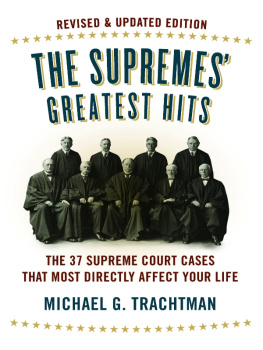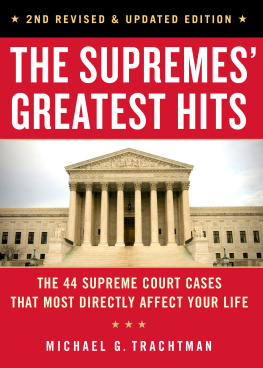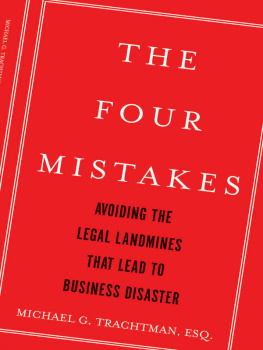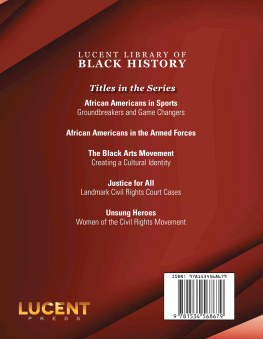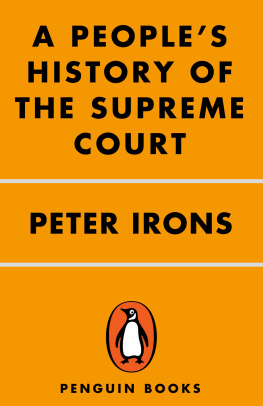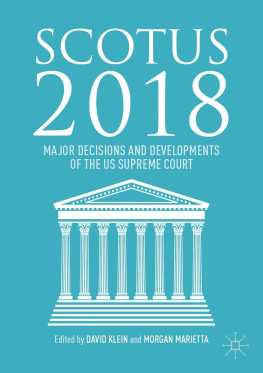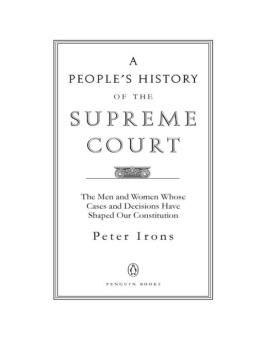THE
SUPREMES
GREATEST
HITS
REVISED & UPDATED EDITION

THE 37 SUPREME COURT CASES
THAT MOST DIRECTLY AFFECT YOUR LIFE

Michael G. Trachtman

New York / London
www.sterlingpublishing.com
STERLING and the distinctive Sterling logo are registered trademarks of
Sterling Publishing Co., Inc.
Frontispiece: U.S. Supreme Court Building, ca. 1943.
Library of Congress Cataloging-in-Publication Data
Trachtman, Michael G.
The Supremes greatest hits : the 37 Supreme Court cases that most directly
affect your life / Michael G. Trachtman.Rev. & updated ed.
p. cm.
Includes bibliographical references.
ISBN 978-1-4027-6826-2 (hc-trade cloth : alk. paper) 1. United States. Supreme Court.
2. Judicial reviewUnited StatesCases. 3. Constitutional lawUnited StatesCases.
4. LawUnited StatesPopular works. I. Title.
KF8742.T73 2009
347.73'260264dc22 | 2009008423 |
1 3 5 7 9 10 8 6 4 2
Published by Sterling Publishing Co., Inc.
387 Park Avenue South, New York, NY 10016
Copyright 2009 Michael G. Trachtman
First edition published in 2007 by Sterling Publishing Co., Inc.
For picture credits please see page 243
Distributed in Canada by Sterling Publishing
c/o Canadian Manda Group, 165 Dufferin Street
Toronto, Ontario, Canada M6K 3H6
Distributed in the United Kingdom by GMC Distribution Services
Castle Place, 166 High Street, Lewes, East Sussex, England BN7 1XU
Distributed in Australia by Capricorn Link (Australia) Pty. Ltd.
P.O. Box 704, Windsor, NSW 2756, Australia
Book design and layout: JAM design
Printed in the United States
All rights reserved
Sterling ISBN 978-1-4027-6826-2
For information about custom editions, special sales, premium and
corporate purchases, please contact Sterling Special Sales
Department at 800-805-5489 or specialsales@sterlingpublishing.com.
CONTENTS
CHAPTER 1
HOW THE SUPREME COURT BECAME SUPREME
Chief Justice Marshall 1803
Did the Supreme Court Trigger the Civil War? 1857
CHAPTER 2
ONE NATION UNDER GOD? MATTERS OF CHURCH AND STATE
The School Prayer Case: Religion in the Public Schools 1962
The Scopes Monkey Trial Revisited: The Teaching of
Evolution, Creationism, and Intelligent Design in
Public Schools 1968
The Ten Commandments Cases: Religion in the
Public Square 2005
CHAPTER 3
INNOCENT UNTIL PROVEN GUILTY: THE RIGHTS OF THE ACCUSED
The Right to Be Represented by Counsel when Charged
with a Crime 1963
You Have the Right to Remain Silent...: The Privilege Against Self-Incrimination 1966
CHAPTER 4
THE MELTING POT: RACE, DISCRIMINATION, AND DIVERSITY
Separate Is Not Equal: The End of Legalized
Segregation 1954
Can One Race Be Favored over Another Race in the
Name of Diversity? 2003
The Right of Expressive AssociationFree Speech
or Legalized Discrimination? 2000
CHAPTER 5
PLAYING POLITICS
Money Talks: Campaign Finance Reform and the First
Amendment 1976
Can an Election Be Bought? 2008
Did the Supreme Court Play Politics in the
2000 Election? 2000
CHAPTER 6
THE RIGHT TO DO WHAT YOU WANT
The Unwritten Right of Privacy 1965
Does the Right of Privacy Include the Right to
an Abortion? 1973
The Right to Die 1997
The Right to Bear Arms 2008
CHAPTER 7
BIG GOVERNMENT IN YOUR BUSINESS AND YOUR BACKYARD
What Gives Congress the Right to Regulate
Private Businesses? 1937
What Are the Limits on Congresss Right to Regulate
Business, and Beyond? 1964
Expanding the Right of Employees to Sue
Their Employers 1998
Eliminating Monopolies and Price-Fixing: John D.
Rockefeller and the Birth of the Antitrust Laws 1911
Can the Government Take Your House to Promote
a Private Business? 2005
You Can Sue City Hall 1961
CHAPTER 8
LIMITING THE IMPERIAL PRESIDENCY
The Steel Seizure Case: How Far Can the President Go
in the Name of National Security? 1952
Nixon, Executive Privilege, and the Watergate Scandal 1974
Who Writes the Rules of War? 2008
CHAPTER 9
HOW FREE IS FREE SPEECH?
The Right to Be Repugnant 1969
Obscenity and the First Amendment 1973
The Flag Burning Case: Can Conduct Be
Free Speech? 1989
The Freedom to Criticize Public Officials and
Public Figures 1964
The Pentagon Papers Case: Balancing National
Security Against the Peoples Right to Know 1971
CHAPTER 10
OLD LAWS AND NEW TECHNOLOGIES
.
Music, Movies, and the Internet 2005
How Much Privacy Are You Entitled to in a
High-Tech World? 2001
The Internet, Free Speech, and the First
Amendment 2003
CHAPTER 11
PRESIDENT OBAMA AND THE SUPREME COURT: WHAT DOES
THE FUTURE HOLD?
It was John Boswells idea that this book should be written, and that I should be the one to write it. I am incredibly grateful for his creativity and generosity, and for the help he has freely given me in my effort to fulfill his vision.
Lawyers sometimes forget how to write and think like non-lawyers. My wife, Jennie, provided invaluable simultaneous translation services as I struggled to overcome those disabilities. Many apologies to her and my son, Ben, for the attention paid to this manuscript at their expense, and many more thanks for their understanding and encouragement.
H igh school civics students are taught that our system of government is comprised of three branches: the legislature makes the laws; the executive enforces the laws; and the courts interpret the laws. As for the Supreme Court, they know that it is the highest court in the landthe final word on legal disputes.
So far as it goes, all of this is true. But to describe the Supreme Court in this way is to describe champagne as grape juice, or the Grand Canyon as a river valleyaccurate to a point, but so shallow and incomplete as to be grotesquely misleading. Over 175 years ago, Alexis de Tocqueville, the celebrated French political observer, studied the Supreme Court and concluded, A more imposing judicial power was never constituted by any people. The same holds true today.
The Ultimate Check and Balance: Judicial Review
Like the highest courts of other democracies, the Supreme Court has the authority to decide, once and for all, what important laws really mean when applied to the real-life situations that arise after the laws are enacted. Does the Civil Rights Act of 1964 protect women against sexual harassment? Does the Americans with Disabilities Act cover people with certain heart conditions? Various lower courts disagreed. The Supreme Court interpreted the wording and intent of the statutes and made a ruling. End of controversy.

